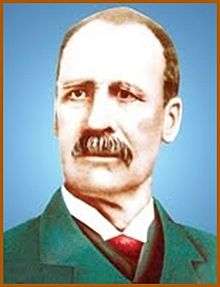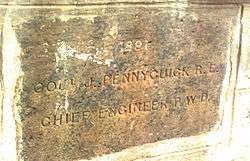John Pennycuick (engineer)

Colonel John Pennycuick CSI (15 January 1841, Pune - 9 March 1911, Camberley) was a British Army engineer and civil servant who served as a member of the Madras Legislative Council when parts of the Indian subcontinent were under Colonial rule of the British East India Company. He undertook several irrigation works which included the masonry dam of Mullaiperiyar on the Periyar River.
Early life
Pennycuick was born on 15 January 1841 at Pune, a younger son of Brigadier-General John Pennycuick and his wife Sarah. His father and eldest brother, Alexander, fought and died at the Battle of Chillianwalla in 1849. He was educated at Cheltenham College.
Career
Pennycuick entered the East India Company Military College at Addiscombe, Surrey, in 1857, and was commissioned as a lieutenant in the Madras Engineer Group in December 1858.[1][2] He arrived in India on 11 November 1860. He became a Second Captain on 15 October 1870;[3] and a major on 8 December 1876.[4] He commanded H company at Zoulla during the Abyssinian campaign of 1868.[5] On 10 October 1895 the Queen nominated him a Companion of the Order of the Star of India.[6] He served in the Public Works Department till January 1896. During his six years of service in the PWD, Pennycuick served as Chief Engineer in the construction of the Mullaperiyar Dam and was awarded a medal for his participation in Abyssinian Expedition of 1867-68.
Pennycuick was nominated to the Madras Legislative Council in November 1893. He was the last president of the Royal Indian Engineering College at Coopers Hill. He also held the position of President of the Sanitary Board and was a faculty in the University of Madras. He received a Telford medal from the Institution of Civil Engineers. The Australian government sought his advice for avoiding damage from flooding of the Brisbane river in 1899. He was also a keen cricketer.
Mullai periyar Dam
Colonel Pennycuick decided to divert the west-flowing Periyar (river)'s culmination in the Arabian Sea towards the East so that it could irrigate lakhs of acres of dry land depending only on Vaigai river.
Though Pennycuick and other British Engineers went ahead with the construction, braving the nature's fury and the dangers of poisonous insects and wild animals, the construction works were disrupted by relentless rain. Large number of sand bags kept for the construction of the dam was destroyed due to severe flood. Since he could not get adequate funds from the British government, Pennycuick went to England and sold his family property to mobilise money to fund the project (Citation Needed), which was completed in 1895.
The dam was inaugurated by Lord Wenlock, the then Governor of the Madras Presidency. It resulted in irrigation of 2.23 lakh acres in Theni, Dindigul, Madurai, Sivaganga and Ramanathapuram districts.
Pennycuick used lime and surki paste for construction, taking into consideration the gravitational force: this allows the dam to withstand tremors and remain strong. Pennycuick said: "I am going to be only once in this earthly world, hence I need to do some good deeds here. This deed should not be prorogue nor ignored since I am not going to be here again".[7]
Family
Pennycuick married Grace Georgina Chamier in 1879. Their son, Sir John Pennycuick, became an English barrister and High Court judge.
Remembrance in Tamil Nadu

- The Public Works Department Office at Madurai houses a life-size bronze statue of Pennycuick. The PWD complex itself was named after Pennycuick by the state government.
- The PWD has erected four statues of Pennycuick on its premises, including a bust at the Periyar dam. The other busts are seen near the PWD Inspection Bungalow in Thekkadi and on its sub-divisional office premises at Uthamapalayam.[8]
- Farmers of Appantirupathi unveiled a granite portrait and distributed sweets on his birth anniversary.
- A memorial to Pennycuick at the Lower Camp in Theni district was unveiled in January 2013.
- A new bus terminus in Theni was named after him in December 2013.[9]
- At Veerapandi (East Street), Balarpatti, Kutchanoor and Kuzhiyanur in Theni district, Pennycuick is remembered during the celebration of the traditional Thai Pongal harvest festival.
- Many children in this area are named after him.
- The people of Palarpatti in Theni district venerated the great man by preparing pongal in front of his statue on his birthday [10]
- * Many of the farmer families of the Theni and Madurai districts still keep portraits of Pennycuick and worship him as a god. Villagers prostrate before his portrait, offer prayers, decorate with garlands and perform aarati to his photos which are usually kept in the hall or in puja room along with images of other gods.[8]
Notes
- ↑ Vibart, H.M. (1894). Addiscombe, its heroes and men of note. Westminster: Archibald Constable. pp. 298, 701.
- ↑ The Singapore Free Press and Mercantile Advertiser (1884-1942), 12 April 1911, Page 2
- ↑ London Gazette, 4 November 1870:4734
- ↑ London Gazette, 29 December 1876:7144
- ↑ London Gazette, 30 June 1868:3676
- ↑ London Gazette, 11 October 1895:5585
- ↑ 'Kumudam' Tamil weekly magazine
- 1 2 http://www.thehindu.com/todays-paper/tp-national/tp-tamilnadu/for-farmers-gratitude-to-pennycuick-knows-no-bounds/article2812915.ece
- ↑ "New Bus Stand in Theni Named After Pennycuick". New Indian Express. 3 January 2014. Retrieved 8 December 2014.
- ↑ http://www.newindianexpress.com/states/tamil_nadu/article332802.ece
References
- Great Britain India Office (1905). The India List and India Office List. London: Harrison and Sons. p. 586.
- Buckland, C. E. (1906). Dictionary of Indian Biography. London: Swan Sonnenschein & Co. p. 334.
- http://www.espncricinfo.com/ci/content/player/18888.html
- S. Muthiah (2 June 2003). "Has the penny dropped right?". The Hindu.
- Booklet in Honour of Man Behind Mullaperiyar Released http://articles.timesofindia.indiatimes.com/2011-12-15/madurai/30519671_1_mullaperiyar-dam-booklet-madhavan